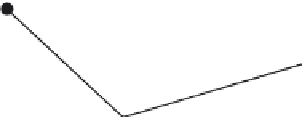Graphics Reference
In-Depth Information
3 DOFs (shoulder)
3 DOFs (wrist)
End effector (hand, fingers)
1 DOF (elbow)
FIGURE 9.6
Basic model of the human arm.
DOFs of the human figure; rather, it is distributed along the forearm itself as the two forearm bones
(radius and ulna) rotate around each other. Sometimes this rotation is associated with the elbow instead;
other implementations create a “virtual” joint midway along the forearm to handle forearm rotation.
Of course, the joints of the human arm have limits. For example, the elbow can flex to approxi-
mately 20 degrees and extend to typically around 180 degrees. Allowing a figure's limbs to exceed
the joint limits would certainly contribute to an unnatural look. Most joints are positioned with least
strain somewhere in the middle of their range and rarely attain the boundaries of joint rotation unless
forced. More subtly, joint limits may vary with the position of other joints, and further limits are
imposed on joints to avoid intersection of appendages with other parts of the body. For example, if
the arm is moved in a large circle parallel to and to the side of the torso, the muscle strain causes
the arm to distort the circle at the back. As another example, in some individuals tendons make it more
difficult to fully extend the knee when one is bending at the hip (the motion used to touch one's toes).
If joint limits are enforced, some general motions can be successfully obtained by using forward
kinematics. Even if an object is to be carried by the hand, forward kinematics in conjunction with
attaching the object to the end effector creates a fairly convincing motion. But if the arm/hand must
operate relative to a fixed object, such as a knob, inverse kinematics is necessary. Unfortunately, the
normal methods of inverse kinematics, using the pseudo-inverse of the Jacobian, are not guaranteed to
give human-like motion. As explained in
Chapter 5
, in some orientations a singularity may exist in
which a DOF is “lost” in Cartesian space. For example, the motion can be hard to control in cases
in which the arm is fully extended.
According to the model shown in
Figure 9.6
, if only the desired end effector position is given, then
the solution space is underconstrained. In this case, multiple solutions exist, and inverse kinematic
methods may result in configurations that do not look natural. As noted in
Chapter 5
, there are methods
for biasing the solution toward desired joint angles. This helps to avoid violating joint limits and pro-
duces more human-like motion but still
lacks any anatomical basis for producing human-like
configurations.
It is often useful to specify the goal position of the wrist instead of the fingers to better control the
configurations produced. But even if the wrist is fixed (i.e., treated as the end effector) at a desired
location, and the shoulder is similarly fixed, there are still a large number of positions that might
be adopted that satisfy both the constraints and the joint limits. Biasing the joint angles to orientations
preferable for certain tasks can reduce or eliminate multiple solutions.
To more precisely control the movement, the user can specify intermediate positions and orienta-
tions for the end effector as well as for intermediate joints. Essentially, this establishes key poses for the








Search WWH ::

Custom Search